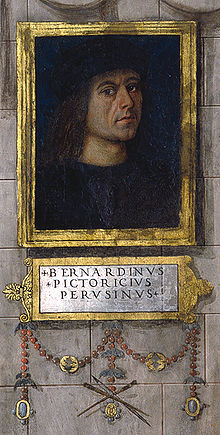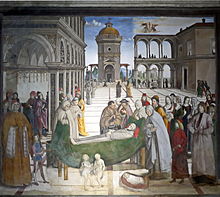Pinturicchio

Pinturicchio , actually Bernardino di Betto di Biagio (* around 1452 in Perugia , † December 11, 1513 in Siena ) was an Italian Renaissance painter . He worked in Rome, Perugia and the Umbrian cities of Spoleto, Spello, Orvieto and from 1502 in Siena. His graceful, colorful frescoes with rich ornamentation underline the decorative effect of the painting. The nickname Pinturicchio (little painter) comes from his small body size. He signed his works with this name.
Life and artistic development
This versatile artist, equally versed in wall, panel and miniature painting, was a typical representative of Umbrian Renaissance painting of the late 15th century with his extensive artistic community, which had its protagonists in Pietro Perugino and later in his great pupil Raphael . His teachers can probably be found among the Umbrian painters of the previous generation such as Fiorenzo di Lorenzo or Bartolomeo Caporali. Giorgio Vasari writes that Pinturicchio worked a lot with his master Perugino in his early youth . Given the age difference of just four years, it is unlikely that he was Perugino's pupil. In the same sentence Vasari states that Pinturicchio received a third of the total proceeds ; unusual for a student. It is undisputed that Perugino had a significant and lasting influence on Pinturicchio. At the time of Sixtus IV he worked with Perugino in Rome. Starting in 1482, he was probably involved in the execution of the frescoes in the Sistine Chapel in Rome as an independent artist with the main contractor Perugino. Florentine art, especially the work of Fra Angelico and even more of his follower and partner Benozzo Gozzoli on the one hand and the work of Filippino Lippi with Fra Diamante in the cathedral of Spoleto (1467) on the other, can be identified as traces in the artist's work. At the beginning of the 1480s, work on the design of the Sistine Chapel in papal Rome was finished. This time saw the meeting of some of the most important Italian painters of the time: Botticelli , Perugino, Ghirlandaio , Luca Signorelli , Cosimo Rosselli and also Pinturicchio, who stayed in Rome and was able to continue his artistic career with important commissions. After the work in the Sistine was completed, most of these masters had left Rome, with the exception of Pinturicchio, who stayed in town, set up a workshop and assembled a heterogeneous group of employees who had worked in the papal chapel. Among them were painters from Umbria, Tuscany, Emilia and Lazio. His first work is ascribed to two panels from a cycle by St. Bernard, in which Perugino was also involved: The Healing of the Lame and The Liberation of a Prisoner were created in Perugia around 1473. The frescoes in the Cappella Sistina in the Vatican, The Circumcision of the Son of Moses and the Baptism of Christ, reveal his characteristic style, in particular the great attention to detail and rich ornamentation in a monumental perspective representation. Pinturicchio received his first large independent commission from Riccomanno Bufalini, the decoration of the Bufalini chapel in the Basilica of Santa Maria in Aracoeli in Rome. He showed that he was fully able to organize and manage such a complex task with many employees. His own style reaches its climax in the furnishing of six rooms in the Vatican, known as the Appartamento Borgia , which Pinturicchio and his workshop decorated with frescoes from 1492–1495. Even while he was working for Pope Alexander VI. was busy, he was commissioned in 1492 for the ceiling fresco of the choir with the four evangelists in Orvieto Cathedral . However, this project never came to fruition. Returning to Umbria, he decorated the Cappella Baglioni in Santa Maria Maggiore in Spello. In 1502 the frescoes Scenes from the Life of John the Baptist and in the library Ten Scenes from the Life of Pius II were painted in the cathedral of Siena . Due to their elegance and graceful style and their splendor of colors, they are considered to be the highlights of his work and may also have influenced Raphael . One of his last important works was the ceiling fresco in the choir of the Basilica Santa Maria del Popolo in Rome, created around 1508 on behalf of Pope Julius II .
For a long time, the negative assessment of Vasari in his vita was detrimental to his fame . It was only art-historical studies in the early 20th century that led to today's high esteem for the artist.
Important works (selection)
- Collaboration on a cycle of images with scenes from the life of Saint Bernardino da Siena (1473) - originally in the Oratorio di San Bernardino in Perugia, today in the Galleria Nazionale dell'Umbria.
- Portrait of a boy (possibly the young Raphael), is now assigned to Pinturicchio (1480–1485) - Gemäldegalerie Alte Meister, Dresden.
- Collaboration on the wall frescoes of the Sistine Chapel together with other artists under the direction of Perugino (1481–1483).
- Fresco cycle scenes from the life of St. Bernardine of Siena in the Cappella Bufalini in the Church of Santa Maria in Aracoeli in Rome by order of Niccolò di Riccomanno Bufalini (1484–1486).
- Frescoes in the Palazzo Colonna in Rome by order of Cardinal Giuliano Della Rovere, later Pope Julius II (1485–1490) - only the ceiling painting survives.
- Altarpiece and frescoes in the former Borgia Chapel (right wing) of the Church of Santa Maria del Popolo in Rome (destroyed).
- Altarpiece and frescoes in the Cappella della Rovere (fig.) Of the Church of Santa Maria del Popolo in Rome (1488–1490) commissioned by Cardinal Domenico della Rovere - by Pinturicchio and his workshop.
- Frescoes in the lunettes of the Cappella Costa of the Church of Santa Maria del Popolo in Rome (1489–1491).
- Madonna of Peace (Madonna della Pace) in San Severino Marche , Pinacoteca civica Tacchi-Venturi
- Frescoes in the apartment of Pope Innocent VIII in the Belvedere - only fragmentary preserved.
- Frescoes in the Palazzo Della Rovere (formerly Palazzo dei Penitenzieri in Rome) by order of Cardinal Domenico della Rovere.
- Frescoes in the Appartamento Borgia in the Vatican (1492–1496) commissioned by Pope Alexander VI.
- Frescoes in the papal apartment of Castel Sant'Angelo by order of Pope Alexander VI. (destroyed)
- Frescoes in the Cappella Baglioni in Santa Maria Maggiore in Spello (Umbria, 1500–1501).
- Cycle of frescoes scenes from the life of John the Baptist in the Duomo of Siena (1502–1505).
- Cycle of frescoes from the life of Enea Silvio Piccolomini (Pope Pius II ) in the Biblioteca Piccolomini in the Cathedral of Siena (1502–1507) on behalf of Cardinal Todeschini Piccolomini and later Pope Pius III.
- Frescoes in the chapel of the Bishop of Eroli in the Cathedral of Santa Maria dell'Assunta in Spoleto .
- Ceiling fresco in the choir vault of the Church of Santa Maria del Popolo in Rome, commissioned by Pope Julius II, (1508–1509).
- Fresco Odysseus and Penelope , formerly in the Palazzo Pandolfo Petrucci in Siena (c. 1509) - is considered to be his only profane work - National Gallery, London.
exhibition
- 2008: Pinturicchio - Galleria Nazionale dell'Umbria, Perugino and the Church of Santa Maria Maggiore, Spello
literature
- Giorgio Vasari : The life of Perugino and Pinturicchio. Newly translated into German by Victoria Lorini. Ed., Commented by introduced by Rudolf Hiller von Gaertringen . Verlag Klaus Wagenbach , Berlin 2011, ISBN 978-38031-5051-6 .
- Ernst Steinmann : Pinturicchio . Published by Velhagen & Klasing 1898
- Cristina Acidini Luchinat: Pinturicchio. The great masters of art. Scala 1999, ISBN 88-8117-436-7 .
- Holly Marguerite Rarick: Pinturicchio's Saint Bernardino of Siena frescoes in the Bufalini Chapel, S. Maria in Aracoeli, Rome: An observant commentary of the late fifteenth century , Case Western Reserve University, 1990.
- Lexicon of Art, Volume IX., Karl Müller Verlag 1994, Erlangen, ISBN 3-86070-452-4
- Bernard Berenson : The Italian Painters of the Renaissance . Phaidon Verlag, Zurich 1952, p. 124 ff.
- Giovanni Battista Vermiglioli: Bernardino Pinturicchio - Memorie . Tip. Baduel = da Vincenzio Bartelli. Perugia 1837.
Web links
- Works by Pinturicchio at Zeno.org .
- The Appartamenti Borgia ( Memento of March 15, 2013 in the Internet Archive )
- Galleria Nazionale dell 'Umbria
- Pictures of Pinturicchio in Art Project
- Vasari, Le vite de 'più eccellenti pittori, scultori e architettori (1568)
- Works by Pinturicchio in the Europeana
Individual evidence
- ↑ Cristina Acidini Luchinat: Pinturicchio, page 3
- ↑ Vasari: avendo dunque costui nella sua prima giovinezza lavorato molte cose con Pietro da Perugia suo maestro
- ↑ Vasari: ... tirando il terzo di tutto il guadagno che si faceva
- ↑ Vasari: ... quando stava con Pietro Perugino ...
- ↑ Cristina Acidini Luchinat: Pinturicchio page 10
- ↑ Padre Guglielmo della Valle: Storia del Duomo di Orvieto . Roma 1791
- ↑ Cristina Acidini Luchinat: Pinturicchio, page 75 f.
- ↑ Schueller Piroli: Borgia. Walter Verlag Olten, 1963, p. 535 ff.
| personal data | |
|---|---|
| SURNAME | Pinturicchio |
| ALTERNATIVE NAMES | Bernardino di Betto di Biagio |
| BRIEF DESCRIPTION | Italian painter of the early Renaissance |
| DATE OF BIRTH | around 1454 |
| PLACE OF BIRTH | Perugia |
| DATE OF DEATH | December 11, 1513 |
| Place of death | Siena |

